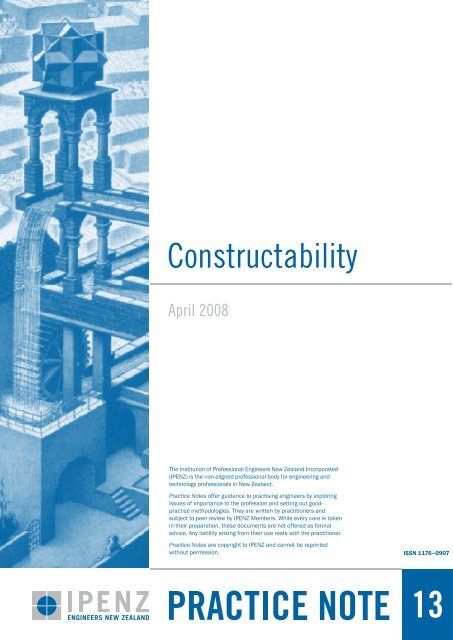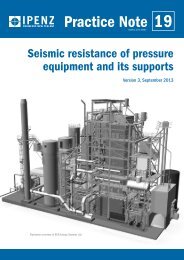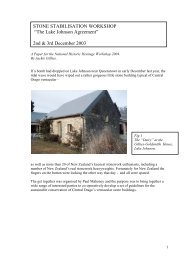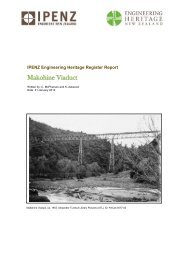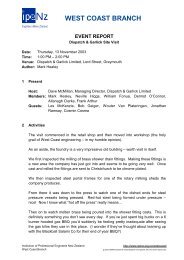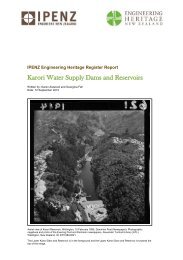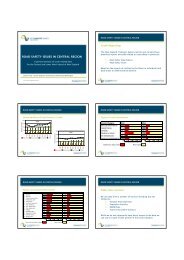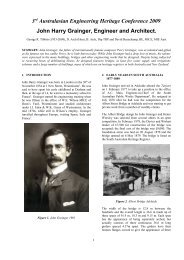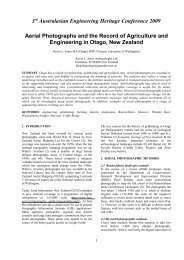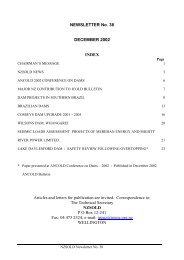Constructability - IPENZ
Constructability - IPENZ
Constructability - IPENZ
Create successful ePaper yourself
Turn your PDF publications into a flip-book with our unique Google optimized e-Paper software.
<strong>Constructability</strong><br />
April 2008<br />
The Institution of Professional Engineers New Zealand Incorporated<br />
(<strong>IPENZ</strong>) is the non-aligned professional body for engineering and<br />
technology professionals in New Zealand.<br />
Practice Notes offer guidance to practising engineers by exploring<br />
issues of importance to the profession and setting out goodpractice<br />
methodologies. They are written by practitioners and<br />
subject to peer review by <strong>IPENZ</strong> Members. While every care is taken<br />
in their preparation, these documents are not offered as formal<br />
advice. Any liability arising from their use rests with the practitioner.<br />
Practice Notes are copyright to <strong>IPENZ</strong> and cannot be reprinted<br />
without permission. ISSN 1176–0907<br />
13
Introduction<br />
As projects get more and more complex the issue of<br />
constructability becomes important. <strong>Constructability</strong> infiltrates<br />
all parts of a project, especially those related to the engineering<br />
and architectural professions. With projects becoming more and<br />
more complex and time frames shorter and shorter, implied<br />
warranty and severe professional liability issues may arise.<br />
Design professionals need to be aware of the potential issues<br />
and claims implied by a design’s constructability or buildability<br />
profile. When a project has inherent constructability issues,<br />
resulting litigation can involve delay claims, change order<br />
issues and disputes, and owner’s dissatisfaction with delivery.<br />
In extreme situations, direct claims may be made against the<br />
design principal for poor plans, specifications or estimates, or<br />
schedules that have made the project difficult to build, or more<br />
costly or time consuming than anticipated.<br />
The issue is well recognised in the construction industry, but<br />
what is not so well recognised is when to do constructability<br />
reviews, who should do them and how they should be done.<br />
This Practice Note provides suggestions and a methodology<br />
for conducting constructability reviews of projects of all types<br />
and sizes. <strong>Constructability</strong> issues not only involve issues<br />
of buildability, but also the sequence of construction and<br />
integration of systems in a logical sequence using standard<br />
substructures.<br />
The Meaning of <strong>Constructability</strong><br />
<strong>Constructability</strong> is a project management technique for<br />
reviewing construction processes from start to finish during the<br />
pre-construction phrase. It will identify obstacles before a project<br />
is actually built to reduce or prevent error, delays and cost<br />
overruns.<br />
The term “constructability” is referred to as:<br />
• the extent to which the design of the building facilitates ease<br />
of construction, subject to the overall requirements for the<br />
completed building<br />
• a system for achieving optimum integration of construction<br />
knowledge and experience in planning, engineering,<br />
procurement and field operations in the building process, and<br />
balancing the various project and environmental constraints<br />
to achieve overall objectives<br />
• a system for achieving optimum integration of construction<br />
knowledge in the building process and balancing the<br />
various project and environmental constraints to maximise<br />
achievement of project goals and building performance<br />
Barriers to Improving <strong>Constructability</strong><br />
Resistance to performing constructability reviews results from a<br />
number of well-known factors, including:<br />
• complacency with the status quo<br />
• reluctance to invest additional money and effort in the early<br />
stages of a project<br />
• limitations of lump-sum and design-build contracts<br />
• lack of construction experience in the design firm<br />
2<br />
• the designers’ perception that they already perform an<br />
analysis<br />
• lack of mutual respect between constructors and designers<br />
• construction input that is requested too late to be of value<br />
Overcoming this resistance involves “changes in procedures,<br />
company culture, and awareness of potential constructability<br />
issues both at the corporate and project level” (O’Connor and<br />
Miller, 1995).<br />
Litigation usually involves the “claim starters” listed below,<br />
which clearly include issues relating to constructability. The<br />
list provides an “insight as to why constructability claims<br />
arise because almost all of these factors relate to inadequate<br />
communication, lack of coordination, and inexperienced<br />
project teams that do not obtain guidance from those who have<br />
previously handled similar projects” (Folk, 2005).<br />
• Site responsibilities are not clear and co-ordinated.<br />
• Client differences are not resolved immediately.<br />
• The construction schedule and budget are not tied to scope.<br />
• The client’s project representative is inexperienced.<br />
• The firm accepts the project with uncompensated risks.<br />
• There are infrequent site observations.<br />
• The client has difficulty making decisions.<br />
• Key issues are resolved after the agreement is signed.<br />
• The firm has a high professional staff turnover rate.<br />
• The consultant’s project staff are inexperienced.<br />
• The firm’s project manager is inexperienced.<br />
• Construction contract administration services are not in the<br />
contract.<br />
• Project agreements are not well co-ordinated.<br />
• The project is fast tracked.<br />
• The construction budget is inflexible.<br />
• There is a high volume of change orders.<br />
• The construction schedule is inflexible.<br />
• Client decisions are not systematically documented.<br />
• The consultant’s project manager is inexperienced.<br />
• The client is a committee.<br />
• The client has a high public profile which generates public<br />
attention, putting pressure on design decision-making<br />
processes.<br />
When Should the <strong>Constructability</strong> Review be<br />
Performed?<br />
Many constructability issues occur as a result of a lack of<br />
communication between the project owner, architect or designer<br />
and the construction company before construction commences.<br />
This is especially so with so-called design-bid-build projects.<br />
Architects, engineers and designers by their nature are not<br />
experts in construction methodologies. For these reasons, and<br />
for “liability reasons, most plans and specifications tend to be<br />
performance oriented, specifying the end result and materials to<br />
be used” (Galvinich, 1995). The lack of communication between<br />
designers and construction companies is often covered or<br />
hidden by the use of performance specifications. While the use<br />
of performance specifications is justified it cannot be overused<br />
in the name of risk management.
By incorporating constructability reviews into the design process<br />
at an early stage, project delivery is more assured and results<br />
in fewer post-construction disputes. However, in New Zealand<br />
many projects are design-bid-build and therefore there is little<br />
opportunity for the construction company to get involved in the<br />
design phase as it is unlikely to be contracted at that time.<br />
The “normal” alternative to performing constructability reviews<br />
during the design process phase is to hire a peer reviewer<br />
consultant. The peer reviewer consultant needs to be a<br />
construction expert with considerable experience in construction<br />
methods and the capacity to run alongside the architects and<br />
engineers during intense design process phases. This is no easy<br />
task and such consultants are rare.<br />
Another approach is to identify the likely tendering construction<br />
companies (perhaps four to six candidates) and ask them<br />
to each provide an experienced construction engineer or<br />
construction manager to form a team to help the designers<br />
develop a buildable solution from the outset. This team could<br />
serve again and again, and lessons learned on one project<br />
could be leveraged into new projects as time goes by. Obviously<br />
this requires some expense from the construction companies,<br />
but the client may well see benefit in providing a consulting fee<br />
for this process, treating it as an investment that returns no<br />
construction surprises or time delays, and fewer litigation issues.<br />
For the professional, this approach may eliminate the issue of<br />
liability for poor plans, drawings and specifications.<br />
A third alternative is for the design company (or the client) to<br />
post relatively complete designs (say 80 per cent and beyond)<br />
on the Internet and request feedback on the design.<br />
<strong>Constructability</strong> reviews should be conducted for all construction<br />
projects irrespective of their size – what changes is the scope<br />
and intensity of the study. For projects circa $2 million or less, a<br />
simple constructability study is performed at initiation, then at<br />
the 90 per cent design stage. For others, say in the $25 million<br />
or less range, constructability reviews are done at initiation, and<br />
at the 30, 60 and 90 per cent design stages. For projects over<br />
$25 million the constructability review process should be more<br />
or less continuous during the entire design phase.<br />
Who Should Perform the <strong>Constructability</strong> Review?<br />
<strong>Constructability</strong> reviews are easily managed for projects<br />
where the contractor is determined beforehand. The preferred<br />
contractor is engaged at the first client briefing stage and is<br />
involved all the way through the design phases. The contractor<br />
is an integral part of all design meetings and reviews all<br />
documents, plans, drawings, specifications, tender documents<br />
and procurement schedules.<br />
Construction companies involved in the tendering phase of<br />
a design-bid-build project must conduct a constructability<br />
analysis before pricing the bid documents. This is usually very<br />
difficult as there has been no prior communication about the<br />
design. <strong>Constructability</strong> reviewers working for the construction<br />
company have to be very experienced and fast on their feet in<br />
order to advise the bidding company on the constructability<br />
issues that are likely to affect costs and schedules. Severe<br />
3<br />
constructability issues on design-bid-build projects can bankrupt<br />
a construction company. There is a greater chance of bankruptcy<br />
if these issues are not identified up front, or if uncompensated<br />
constructability risks are not properly analysed.<br />
A constructability analysis must be a principal component<br />
of a construction company’s integrated approach to risk<br />
management. Construction companies that do not undertake<br />
a constructability analysis and review increase their risk profile,<br />
as the idea is to identify, categorise, quantify and then reduce<br />
or eliminate the risk. Design risk is, by its very nature, an<br />
expression of constructability.<br />
For build-own-operate-transfer (BOOT) projects (where the<br />
construction company is entirely responsible for all project<br />
design and construction), in the absence of an internal<br />
constructability review function the company must bring in<br />
external constructability expertise to establish a rigorous design<br />
review that is fully buildable, without excessive costs or time<br />
delays. This requires designers to provide their designs for<br />
external review at all levels, something that some architects are<br />
unwilling to do.<br />
A constructability review is easy to implement for projects<br />
employing the principles of “alliancing”, especially those related<br />
to large public works which by their nature employ a “just in<br />
time” design process. This is because the entire team, from<br />
designers and engineers to those involved in construction and<br />
commissioning (see <strong>IPENZ</strong> Practice Note 09 “Commissioning<br />
Capital Plant”), are all on the same side, sharing project “gain”<br />
and “pain”. In this kind of relationship communication pathways<br />
are very strong and co-operative, and all participants can<br />
contribute expertise to the constructability review. There are<br />
generally few litigation issues related to constructability, as any<br />
difficulties are worked out at an early stage and there are no<br />
constructability surprises.<br />
Regardless of construction option, project timeframe or size,<br />
the constructability review should commence at the client brief<br />
stage and run right through the design process stages and into<br />
construction. The constructor must be involved in reviewing<br />
constructability at all design stages.<br />
The project must have an integrated information source system<br />
to capture the lessons learned throughout all project phases.<br />
This includes what went wrong, what went right, change orders,<br />
variations and commissioning reports. The construction team<br />
needs to provide a continuous stream of information into<br />
the database so that when the next project is started the<br />
constructability review is up to date.<br />
The <strong>Constructability</strong> Review and Analysis Process<br />
A constructability review and analysis comprises a review of<br />
documentation and its completeness and adequacy for the<br />
task at hand, and an analysis of buildability, logical sequencing,<br />
scheduling and complexity of project elements.<br />
Complexity analysis determines whether or not elements can<br />
be simplified. This is especially important for infrastructure<br />
elements such as piping and cabling in, for example, a large
complex building with a complicated services function. Rising<br />
cable ways and similar systems are analysed to see if a simpler<br />
installation system could save cost, time and construction<br />
frustration. For example, a rising service duct may be sized<br />
by the designer so that the construction company cannot<br />
use a standard support stanchion and a special one must be<br />
fabricated. If several hundred rising ducts are required then<br />
a case could be made during the constructability analysis to<br />
simplify this element by redesigning the rising duct so that the<br />
standard bracket can be used.<br />
The main objective of a constructability review should be to<br />
minimise or eliminate potential change orders and schedule<br />
delays during construction by ensuring that the construction<br />
documents are fully co-ordinated, complete and buildable. A<br />
constructability review should also seek to eliminate redundancy<br />
in quality control reviews performed by different entities involved<br />
in the project, such as architects, peer reviewers and permitting<br />
agencies.<br />
The scope of the review cannot be limited to a review of contract<br />
documents provided by the architect. Traditionally, owners<br />
provide integral portions of the contract documents, such<br />
as survey, as-site existing, geotechnical, hazardous material,<br />
environmental and other pre-construction documentation.<br />
All elements that “make up the contract documents need<br />
to be concurrently reviewed – drawings, as-built conditions,<br />
specifications, geotechnical reports, environmental documents,<br />
site topographic and utility surveys, etc” (Pruett, 2004).<br />
Personnel<br />
The right personnel and tools are necessary to effectively<br />
execute the review. A common approach is to:<br />
• establish a multidisciplinary review team with constructionexperienced<br />
personnel<br />
• create comprehensive constructability management tools<br />
which are provided to the reviewers<br />
• conduct constructability audits on projects either under<br />
construction or completed to ascertain and prevent recurring<br />
bid document errors<br />
• conduct site visits to verify site topographic, utility, easement,<br />
surrounding public utility and other existing conditions<br />
Individuals with direct construction field experience should be<br />
selected to perform constructability reviews. The most qualified<br />
“constructability reviewers are those individuals that have<br />
dealt with the by-product of bid document errors and omissions<br />
in the field. Supervisors, inspectors, or managers who have<br />
been involved in resolving unclear construction conditions or<br />
settling change orders and claims have an excellent background<br />
that can be applied in the up front constructability reviews”<br />
(Pruett, 2004). Their knowledge, combined with some form<br />
of a constructability checklist derived from audits of previous<br />
projects and changes, is necessary for a comprehensive and<br />
successful constructability review.<br />
4<br />
The initial programme, design and peer reviews are typically<br />
done by architects and engineers and are viewed from a<br />
designer’s perspective. In contrast, the constructability review<br />
team views the documents from a builder’s perspective. The<br />
review team needs to have management tools that act as a<br />
guide to finding missing or unco-ordinated contract document<br />
information, including a detailed constructability scope of work.<br />
The team must be able to continually build upon and access a<br />
“lessons learned” database of specific problem areas.<br />
The detailed constructability scope of work defines areas to be<br />
reviewed in the documents and assigns multidisciplinary team<br />
members responsible for completing them. In practice, each<br />
reviewer is responsible for catching comments such as “see<br />
structural”, “provided by others” or “provide as required” and<br />
frequently repeated errors or omissions that have resulted in<br />
variations or change orders on previous projects (Pruett, 2004).<br />
A professional journal is an important tool for an engineer<br />
engaged to perform a constructability review. The engineer<br />
can use his or her journal to log the lessons learned during<br />
construction and the output of the review process, so that this<br />
information can be fed into the next project.<br />
Following a constructability review, the designer incorporates the<br />
constructability comments (this is called back-checking). Several<br />
meetings with the architect or engineer after the review may be<br />
necessary to resolve all of the identified issues. The project team<br />
should reach a consensus on whether or not to incorporate each<br />
constructability comment.<br />
The constructability review will pay for itself if it is conducted<br />
properly and focused on the issues that affect buildability. It<br />
can be difficult to quantify the financial savings delivered by<br />
the review as the stage of construction in which an error is<br />
discovered has the biggest impact on its cost. However, only a<br />
few of the major and recurring issues need to be identified to<br />
realise its value.<br />
It is essential that the review and analysis process is systemised<br />
so that it follows a set procedure. Either an expert computerbased<br />
system or a simple matrix (see Table 1 for an example)<br />
can be used. The required elements are arranged in a sequence<br />
allowing all components to be located and easily applied.
Table 1: Matrix for <strong>Constructability</strong> Review and Analysis<br />
Part 1 Part 2 Part 3 Part 4<br />
Section <strong>Constructability</strong> review<br />
(Form set A1000)<br />
Section 1<br />
Client brief<br />
Section 2<br />
Design<br />
Section 3<br />
Site inspection<br />
Section 4<br />
Drawings and<br />
plans<br />
Section 5<br />
GA, layouts, scope<br />
• Building purpose<br />
• Fitness<br />
• Functionality<br />
• Buildable<br />
• Difficult elements<br />
• Uncompensated risks<br />
• Design risk<br />
• Resource risk<br />
• Load lift risk<br />
• Construction risk<br />
• Erection risk<br />
• Commissioning risk<br />
• Easements<br />
• Utility access<br />
• Location<br />
• Storage<br />
• Activity<br />
• Lay down<br />
• Boneyard<br />
• Hard arrival receival<br />
• Telecoms and comms<br />
• Traffic<br />
• Public<br />
• Accuracy<br />
• Completeness<br />
• Nomenclature<br />
• Schedules and tables<br />
• Vendor-supplied bid documents<br />
• Utility or agency bid documents<br />
• Environmental documentation<br />
• Resource consent documents<br />
• Consent conditions<br />
• Complete geotech surveys<br />
• Nomenclature<br />
• Orientation<br />
• Locations<br />
• Floor elevations<br />
• Tilts, slabs, beams, columns<br />
• Fitout<br />
• Glazing<br />
• Piping and cables<br />
• Cable racking<br />
• machine platforms<br />
• HVAC systems standardised<br />
• Sizes standardised<br />
• Brackets and support structures<br />
standardised<br />
• Types rationalised<br />
• Translatable to subcontractor<br />
level with minimum instruction<br />
• Oriented to operations and<br />
maintenance<br />
• Oriented to commissioning<br />
<strong>Constructability</strong> analysis tools<br />
(Form set B1000)<br />
Decision support system<br />
(DSS) tool to ascertain<br />
building is “on strategy”.<br />
DSS to determine veracity<br />
of buildability, construction<br />
of difficult elements, and<br />
completeness of design to<br />
permit construction.<br />
Value engineering for risk<br />
analysis during construction.<br />
DSS to determine if all the<br />
activity can be performed on<br />
the site.<br />
Schedule analysis to<br />
determine errors and<br />
omissions that lead to<br />
constructability and time<br />
delay issues.<br />
Standardisation analysis<br />
is used to determine if<br />
all physical systems use<br />
standard methods and<br />
systems, so that overengineering<br />
is not used in the<br />
design process.<br />
5<br />
Quality assurance<br />
(Form set C1000)<br />
S1C1000 question<br />
set<br />
S2C1000<br />
question set<br />
S3C1000<br />
question set<br />
S4C1000<br />
question set<br />
S5C1000<br />
question set<br />
Review reports<br />
(Form set D1000)<br />
S1D1000<br />
report<br />
S2D1000<br />
report<br />
S3D1000<br />
report<br />
S4D1000<br />
report<br />
S5D1000<br />
report
Section 6<br />
Schedules<br />
Section 7<br />
Performance<br />
specifications<br />
Part 1 Part 2 Part 3 Part 4<br />
• Standardised for all elements and<br />
systems<br />
• Correctly tied to nomenclature<br />
• Oriented to commissioning<br />
• Minimal reference to “as<br />
required”<br />
• Translatable to subcontracts with<br />
minimum instruction<br />
Key Points for the <strong>Constructability</strong> Reviewer<br />
Bid documents<br />
The constructability review should never target only the bid<br />
documents provided by the designer. Although the bulk of the<br />
bid documents will be produced by the architect or engineer,<br />
the effect of owner-furnished, utility agency or environmental<br />
documentation needs to be concurrently reviewed.<br />
Back-checking<br />
Following a constructability review, the designer incorporates<br />
the constructability comments. Several meetings with the<br />
architect or engineer after the review may be necessary to<br />
resolve all of the identified issues. The project team should<br />
reach a consensus on whether or not to incorporate each<br />
constructability comment.<br />
<strong>Constructability</strong> team members<br />
The right personnel and tools are necessary to effectively<br />
execute the review.<br />
Two parts to constructability<br />
A constructability review and analysis comprises a review of<br />
documentation and its completeness and adequacy for the<br />
task at hand, and an analysis of buildability, logical sequencing,<br />
scheduling and complexity of project elements.<br />
<strong>Constructability</strong> scope of work<br />
The detailed constructability scope of work defines areas to be<br />
reviewed in the documents and assigns multidisciplinary team<br />
members responsible for their completion.<br />
Knowledge management<br />
A database of lessons learned, critical decisions and design<br />
elements from previous projects, can, on a company-by-company<br />
basis, create a checklist for future design teams working on<br />
new projects. Knowledge management in this area within the<br />
construction industry becomes a critical link between risk<br />
management and constructability. Individual engineers’ lessons<br />
learned could be extracted from their professional journals<br />
(perhaps with specific software) and deposited in a communal<br />
database, thereby becoming the feedstock of such a knowledge<br />
management process.<br />
Standardised analysis is used<br />
to ensure that all the tables<br />
and schedules are structured<br />
to follow the design and are<br />
simple to follow and oriented<br />
to commissioning.<br />
Errors and omissions analysis<br />
are used to determine<br />
accuracy and veracity of<br />
performance specifications<br />
so that there are no<br />
uncompensated risks.<br />
6<br />
S6C1000<br />
question set<br />
S7C1000<br />
question set<br />
S6D1000<br />
report<br />
S7D1000<br />
report<br />
The review<br />
The main objective of a constructability review should be to<br />
minimise or eliminate potential change orders and schedule<br />
delays during construction by ensuring that the construction<br />
documents are fully co-ordinated, complete and buildable. A<br />
constructability review should also seek to eliminate redundancy<br />
in quality control reviews performed by different entities involved<br />
in the project, such as architects, peer reviewers and permitting<br />
agencies.<br />
Further Reading<br />
Folk, P 2005, <strong>Constructability</strong>: Does the Design Convey Enough<br />
Information?, Victor O. Schinnerer & Company.<br />
<strong>IPENZ</strong> 2007, Practice Note 09 “Commissioning Capital Plant”,<br />
<strong>IPENZ</strong>.<br />
Pruett, K 2004, Case Study of Bid Documents Errors and<br />
Omissions, Construction Management Association of America.<br />
Wright, E 1994, <strong>Constructability</strong> Guide, Obrien-Kreitzberg Assoc<br />
Inc.<br />
Fisher, D et al 2000, Integrating <strong>Constructability</strong> Tools into<br />
<strong>Constructability</strong> Review Process, Journal of Construction<br />
Engineering and Management, Vol.126 No.2, pp.89-96.<br />
Acknowledgements<br />
This Practice Note was developed by Dr Ir. Ron McDowall. It was<br />
peer reviewed by Dr John Tookey (University of Auckland) and<br />
Bruce Adin (Northern Regional Manager, Ministry of Education).
For more information, contact:<br />
National Office<br />
PO Box 12 241<br />
Wellington 6144<br />
New Zealand<br />
T 64 4 473 9444<br />
F 64 4 474 8933<br />
E ipenz@ipenz.org.nz<br />
W www.ipenz.org.nz


